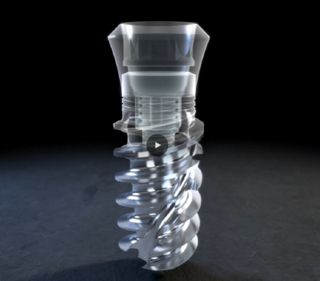With these design features adapted from the Straumann® BLX Implant System, high primary stability can be achieved even in relatively soft bone3. Due to the biomechanical strength of the titanium-zirconium alloy Roxolid®, narrow 3.75 mm diameter Straumann® TLX implants can be used for all indications, including posterior replacements. The combination of maximum primary stability and reduced implant dimensions allows for non-augmentation implantology, even in many cases with minimal bone dimensions4. At the same time, the number of sessions and overall treatment time can be reduced, thereby increasing patient satisfaction and practice efficiency.

Features and benefits
Straumann® developed the TLX Implant System for efficient protocols, both from a surgical and prosthetic point of view.
Clinical versatility and ease of use
Analogous to the original Tissue Level, Straumann® TLX implants can be used in a wide range of clinical indications, including immediate protocols and the rehabilitation of periodontally or systemically compromised patients. In most cases a transgingival protocol can be used, enabling many patients to receive a “one-stage” treatment, i.e., with only one surgical intervention. This applies especially to situations with adequate preoperative bone dimensions and a thick gingival biotype.

The new TLX in the eyes of international experts
What do international experts in implantology think about the new Straumann® TLX Implant System?
Indications for the TLX include single posterior gaps, wider edentulous spaces, free-end situations and edentulous ridges, all of which can be restored in a convenient and predictable way5, 6. The wider diameter of the TLX implant shoulder in comparison with the endosteal part makes it easier to create a natural emergence profile of the crown, even in combination with narrow implants (Figs. 1-3)7. In small gaps a Straumann® TLX narrow neck implant with parallel transgingival collar design can be used.
Learn more about the potentials of the Straumann® TLX Implant System:
Photos (Figs. 1-3) courtesy of Dr. Mario Rocuzzzo, DT Francesco Cataldi (both Italy) – see case report here
Like the Straumann® BLX, the TLX Implant System is equipped with the TorcFit™ internal conical connection. This interface allows simple handling of prosthetic components, including placement of abutments at the soft tissue level. Direct-to-implant restoration without abutments is also an option (Figs. 4-6), e.g., for the immediate restoration of edentulous ridges with the Straumann® ProArch concept. According to many clinicians’ daily experience the transgingival collar of the TLX effectively promotes soft tissue adaptation and healing around caps or immediate restorations (Figs. 2,5).
Photos (Figs. 4-6) courtesy of Dr. Eirik Salvesen, Stavanger (Norway) – see case report here
Long-term evidence and ongoing studies
The technology behind the Straumann® TLX Implant System rests on a solid foundation of scientific evidence. It starts with the high-strength implant material Roxolid®, which is composed of 85% titanium and 15% zirconium. In combination with the hydrophilic SLActive® surface, implants manufactured from Roxolid® have shown excellent survival and tissue stability, e.g., in narrow-diameter implants used for mandibular overdentures after 5 years8, 9. These implants have also proven successful in patients with type 2 diabetes mellitus10.
Concerning the Straumann® TLX Implant System itself, a preclinical study was carried out to define the design of ongoing clinical investigations11. A case report was published showing successful immediate loading of a maxillary first molar12. Finally, multicenter clinical studies are underway in more than 10 countries worldwide to further prove the clinical applicability of the system.

How to become an expert
The Straumann® TLX Implant System is built on a strong basis of scientific studies and educational material.

Want to stay up to date?
youTooth.com is THE PLACE TO BE IN DENTISTRY – subscribe now and receive our monthly newsletter on top hot topics from the world of modern dentistry.
